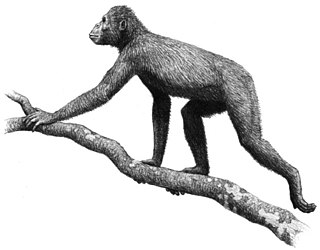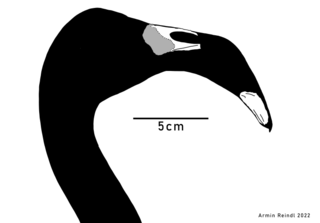Paleoanthropology or paleo-anthropology is a branch of paleontology and anthropology which seeks to understand the early development of anatomically modern humans, a process known as hominization, through the reconstruction of evolutionary kinship lines within the family Hominidae, working from biological evidence and cultural evidence.

Proconsul is an extinct genus of primates that existed from 21 to 17 million years ago during the Miocene epoch. Fossil remains are present in Eastern Africa, including Kenya and Uganda. Four species have been classified to date: P. africanus, P. gitongai, P. major and P. meswae. The four species differ mainly in body size. Environmental reconstructions for the Early Miocene Proconsul sites are still tentative and range from forested environments to more open, arid grasslands.

Paranthropus aethiopicus is an extinct species of robust australopithecine from the Late Pliocene to Early Pleistocene of East Africa about 2.7–2.3 million years ago. However, it is much debated whether or not Paranthropus is an invalid grouping and is synonymous with Australopithecus, so the species is also often classified as Australopithecus aethiopicus. Whatever the case, it is considered to have been the ancestor of the much more robust P. boisei. It is debated if P. aethiopicus should be subsumed under P. boisei, and the terms P. boisei sensu lato and P. boisei sensu stricto can be used to respectively include and exclude P. aethiopicus from P. boisei.

Proconsul africanus was an ape which lived from about 23 to 14 million years ago during the Miocene epoch. It was a fruit eater and its brain was larger than that of a monkey, although probably not as large as that of a modern ape.

Victoriapithecus macinnesi was a primate from the middle Miocene that lived approximately 15 to 17 million years ago in Northern and Eastern Africa. Through extensive field work on Maboko Island in Lake Victoria, Kenya, over 3,500 specimens have been found, making V. macinnesi one of the best-known fossil primates. It was previously thought that perhaps multiple species of Victoriapithecus were found, however the majority of fossils found indicate there is only one species, V. macinnesi. Victoriapithecus shows similarities to the extant subfamilies Colobinae and Cercopithecinae. However, Victoriapithecus predates the last common ancestor of these two groups and instead is thought to be a sister taxon.

Rusinga Island, with an elongated shape approximately 10 miles (16 km) from end to end and 3 miles (5 km) at its widest point, lies in the eastern part of Lake Victoria at the mouth of the Winam Gulf. Part of Kenya, it is linked to Mbita Point on the mainland by the new Rusinga-Mbita bridge which replaced the old causeway.

Proconsulidae is an early family of primates that lived during the Miocene epoch in Kenya, and was restricted to Africa. Members of the family have a mixture of Old World monkey and ape characteristics, so the placement in the ape superfamily Hominoidea is tentative; some scientists place Proconsulidae outside of Hominoidea in a separately superfamily Proconsuloidea, before the split of the apes and Old World monkeys.

Indopithecus giganteus is an extinct species of large ape that lived in the late Miocene of the Siwalik Hills in northern India. Although frequently assigned to the more well-known genus Gigantopithecus, recent authors consider it to be a distinct genus in its own right.

Nakalipithecus nakayamai, sometimes referred to as the Nakali ape, is an extinct species of great ape from Nakali, Kenya, from about 9.9–9.8 million years ago during the Late Miocene. It is known from a right jawbone with 3 molars and from 11 isolated teeth. The jawbone specimen is presumed female as the teeth are similar in size to those of female gorillas and orangutans. Compared to other great apes, the canines are short, the enamel is thin, and the molars are flatter. Nakalipithecus seems to have inhabited a sclerophyllous woodland environment.
Karanisia is an extinct genus of strepsirrhine primate from middle Eocene deposits in Egypt.

Saadanius is a genus of fossil primates dating to the Oligocene that is closely related to the common ancestor of the Old World monkeys and apes, collectively known as catarrhines. It is represented by a single species, Saadanius hijazensis, which is known only from a single partial skull tentatively dated between 29 and 28 million years ago. It was discovered in 2009 in western Saudi Arabia near Mecca and was first described in 2010 after comparison with both living and fossil catarrhines.
Simiolus is an extinct genus of dendropithecid primates. It was described by Mary Leakey and Richard Leakey in 1987, and the type species is S. enjiessi, which existed during the Miocene of Kenya. The species epithet is a phonetic pun on the acronym NGS. A new species, S. andrewsi, also from the middle Miocene of Kenya, was described by Terry Harrison in 2010. In November 2018, scientists reported the discovery of the smallest known ape, Simiolus minutus, which weighed approximately 8 lb (3.6 kg), and lived about 12.5 million years ago in Kenya in East Africa.

Kanapoi is a paleontological site in the Kenyan Rift Valley, to the southwest of Lake Turkana. Fossils were first found at Kanapoi in the 1960s by a Harvard expedition, and later by expeditions from the National Museums of Kenya.

The family Dendropithecidae is an extinct family of catarrhine monkeys. They date from the Early Miocene, around 20 - 12 million years ago.
The Nyanzapithecinae or Nyanzapithecines are a subfamily of extinct Dendropithecidae as sister of Simiolus. The group contains Rangwapithecus, Turkanapithecus, Rukwapithecus, Oreopithecus, and Nyanzapithecus. In the following tree the internal structure of Nyanzapithecinae of Nengo et al. is followed.
Micropithecus is an extinct genus of primates that lived in East Africa about 19 to 15 million years ago, during the early Miocene. The genus and its type species, Micropithecus clarki, were first scientifically described in 1978.

Nyanzapithecus is an extinct genus of primate from the Middle Miocene of Maboko Island, Nyanza Province, Kenya. This genus is known from four species. It had an average body mass of around 10 kg (22 lb).
The Hiwegi Formation is a geological formation on Rusinga Island in Kenya preserving fossils dating to the Early Miocene period. The Hiwegi Formation is known for the well preserved plant fossils it preserves, which indicate a tropical forest environment that underwent wet and dry periods. The middle members of the formation in particular indicate a brief period in which conditions were notably dryer with a more open environment compared to older and younger units. Some of the formation's fauna, such as an early ancestor of the modern aye-aye and a chameleon of the genus Calumma, link Miocene East Africa to modern day Madagascar.

Leakeyornis is an extinct genus of flamingo from the early to middle Miocene of Kenya, primarily in the area of modern day Lake Victoria. Initially described as a species of Phoenicopterus based on an incomplete skull and various limb bones, it was later found to show a mixture of traits found across modern flamingo genera and subsequently placed in its own genus. It contains a single species, Leakeyornis aethiopicus.












